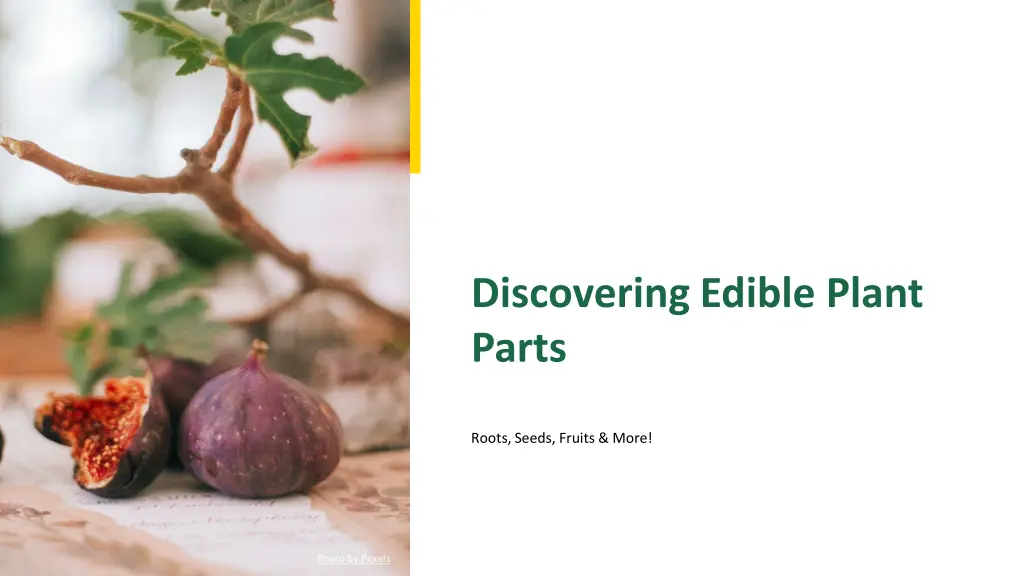
Exploring the Edible Parts of Plants: Roots, Seeds, Fruits, and More!
Discover the diverse and nutritious edible plant parts, from roots like carrots and turnips to seeds such as sunflower seeds, along with the sweet and savory treats of fruits like apples and blueberries. Learn about the culinary potential of flowers and the health benefits of leafy greens like kale and spinach. Enhance your meals and diet with a variety of plant-based ingredients.
Download Presentation

Please find below an Image/Link to download the presentation.
The content on the website is provided AS IS for your information and personal use only. It may not be sold, licensed, or shared on other websites without obtaining consent from the author. If you encounter any issues during the download, it is possible that the publisher has removed the file from their server.
You are allowed to download the files provided on this website for personal or commercial use, subject to the condition that they are used lawfully. All files are the property of their respective owners.
The content on the website is provided AS IS for your information and personal use only. It may not be sold, licensed, or shared on other websites without obtaining consent from the author.
E N D
Presentation Transcript
Discovering Edible Plant Parts Roots, Seeds, Fruits & More! Photo by Pexels
01 The Roots of Flavor Table of Contents 02 Seeds: Nature's Powerhouses 03 Fruits: Nature's Treats 04 The Beauty of Flowers 05 Leafy Greens: Vital Nutrients 06 Stems: The Unsung Heroes 07 Why Eating Plants Matters? 08 Growing Your Own Food 09 The Joy of Cooking with Plants 10 Thank You for Joining!
1 The Roots of Flavor Understanding Roots Roots are the underground parts that anchor plants and absorb nutrients and water from the soil. Common edible roots include carrots, beets, turnips, and rutabagas, each packed with nutrients. Roots not only provide energy but also enhance the taste of various dishes. Incorporating a variety of roots can elevate your meals and garden experience. Photo by Pexels
2 Seeds: Nature's Powerhouses The Essence of Life Seeds serve as the reproductive parts of plants, containing the potential for new life. Lima beans, peas, green beans, sunflower seeds, and black- eyed peas are nutritious and versatile. Seeds are rich in proteins, fibers, and healthy fats, beneficial for diet and health. Embrace the versatility of seeds in meals and snacks for a healthylifestyle. Photo by Pexels
3 Fruits: Nature's Treats Sweet & Savory Fruits are the mature ovary of flowering plants, often sweet or savory, and packed with flavor. Popular edible fruits include tomatoes, apples, cucumbers, strawberries, and blueberries. Fruits are important for hydration and provide essential vitamins and antioxidants. Including a variety of fruits enhances your diet and adds color to your meals. Photo by Pexels
4 The Beauty of Flowers More Than Just Blooms Flowers are the reproductive structures of plants, often overlooked as food sources. Edible flowers like broccoli, cauliflower, squash blossoms, and nasturtiums are delightful additions. They provide unique flavors and can elevate dishes visually and gastronomically. Explore culinary possibilities with edible flowers for a creative touch in cooking. Photo by Pexels
5 Leafy Greens: Vital Nutrients Diverse and Delicious Leaves are crucial for photosynthesis and come in various textures and flavors. Kale, lettuce, spinach, cabbage, collards, and mustard are packed with vitamins and minerals. Incorporating leafy greens into your diet promotes health and well-being. Experiment with salads and smoothies to enjoy the benefits of leafy greens. Photo by Pexels
6 Stems: The Unsung Heroes Supportive Structures Stems support the plant and transport nutrients between roots and leaves. Edible stems include celery, rhubarb, and onions, each offering distinct flavors. Utilizing stems in cooking can add crunch and enhance the overall dish. Don t forget to include stems for added texture and nutrition in your meals. Photo by Pexels
7 Why Eating Plants Matters? Health Benefits Eating a variety of plant parts promotes a balanced diet and sustainability. Plant-based foods are linked to lower risks of chronic diseases and obesity. Choosing whole, plant-based foods fosters a healthier lifestyle for you and the planet. Embrace plant diversity for both taste and health benefits. Photo by Pexels
8 Growing Your Own Food A Rewarding Journey Gardening allows you to grow your own edible plants, promoting sustainability. Starting with easy-to-grow plants like lettuce can be fulfilling and educational. Engaging in gardening teaches valuable skills and connects you with nature. Join the movement of growing your own food for a sustainable future. Photo by Pexels
9 The Joy of Cooking with Plants Creativity in the Kitchen Cooking with various edible plant parts inspires creativity in meal preparation. Explore new recipes that showcase the unique flavors of roots, seeds, and fruits. Cooking with plants encourages healthier food choices and brings family together. Celebrate the vibrancy of plant-based meals for a more enjoyable culinary experience. Photo by Pexels
10 Thank You for Joining! Let's Explore More Together Thank you for exploring the edible parts of plants with us today! We hope you feel inspired to include more plant variety in your diet. Join us in celebrating the beauty and benefits of plants every day! Let s continue our journey towards healthier choices and sustainable living. Photo by Pexels
